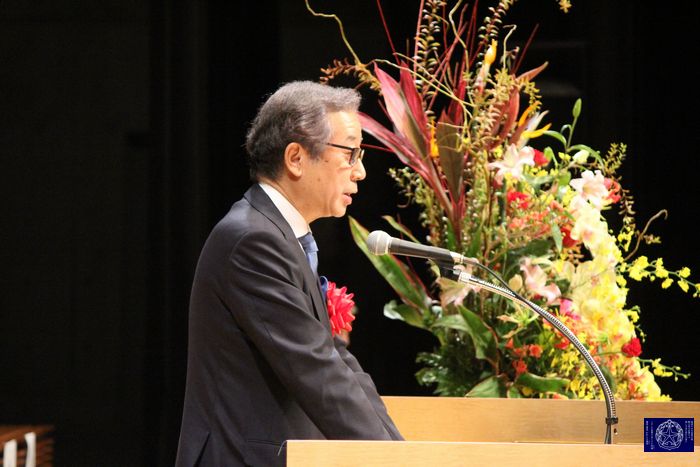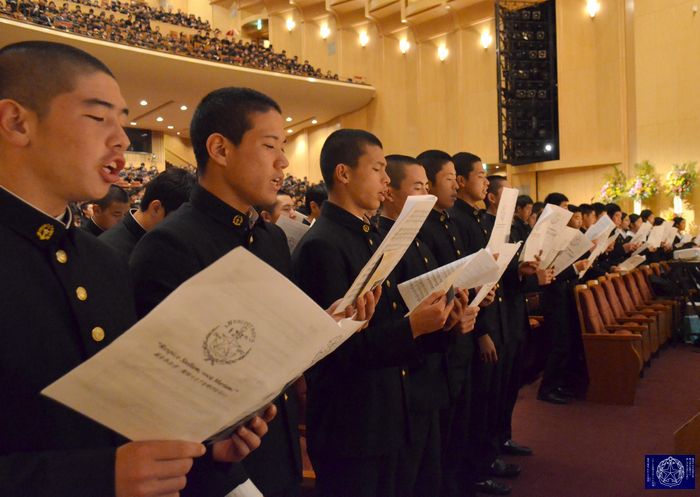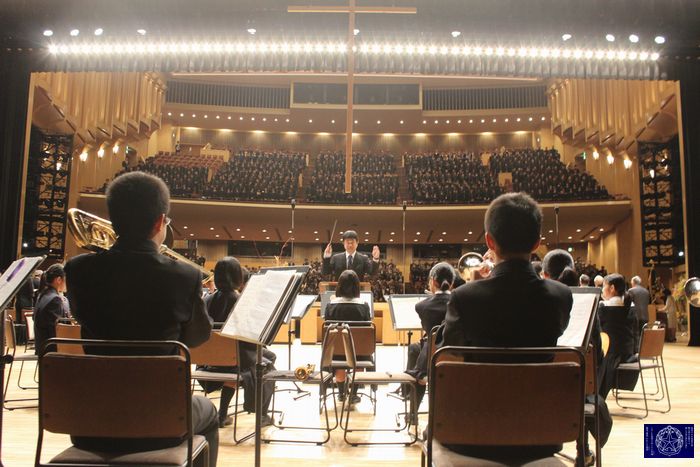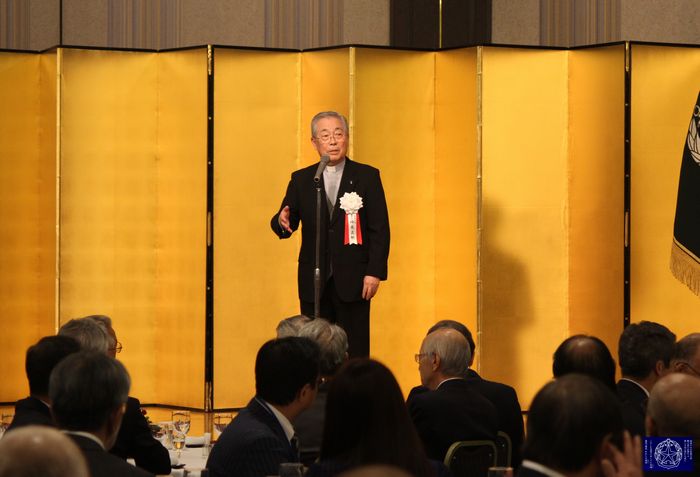
It drizzles.
The temperature that is warmer than yesterday this morning is 14 degrees Celsius.
I translate it into English, and you see “the kaisei blog” which I introduced on November 2 today.
The English sentence to here is a thing by the blog person in charge.Very uneasy.The following English sentence is a thing by Akiko Hara child teacher and the friend.
Please enjoy it.
(小雨が降っています。昨日より暖かい、今朝の気温は14℃です。本日の海星ブログは、11月2日に紹介させていただいた『海星ブログ』を英訳してご覧頂きます。ここまでの英文はブログ担当者による英文です。とても不安が残ります。以下は英語科、原彬子先生を中心に英訳されたものです。どうぞお楽しみ下さい。)
125th Anniversary Ceremony
We held an anniversary ceremony and celebration on November 1st.
It was held at Nagasaki Brick Hall. The ceremony began by watching a DVD about the history of our school.

The school was founded by Fathers Jacques Barth, Celestin Rambackh, Leopold Baumann and Joseph Guthleben with Father Jacques Barth as the first principal of the school.
There were 19 students after Kaisei was first established. It was after 5 years that a member of the Society of Mary visited Japan for the first time.
Kaisei was established as the second educational project in Japan. The first was “Gyosei” which was built in Tokyo in 1888.

Kaisei moved to Higashiyamate-machi in 1895. We can see Nagasaki Harbor from there. Before then, there were already some other schools in Higashiyamate. Notably “Kassui Jogakuin” (established in 1879), “Chinzenigakkan” (established in 1881) and “Higashiyamagakuin” (established in 1884). They could all share the beautiful view from Higashiyamate-machi.
In 1897, Mr. Joseph Guthleben was inducted into Kaisei as the second principal and, in 1898, Mr. Nicholas Waltel became the third principal. After that, in 1901 Mr. Emilien Perrin came to Kaisei as the fourth principal.


In 1903, Kaiseigakkou changed into “Kaisei Commercial School.”
In those days, Nagasaki Harbor was well known as the top trading port in Japan and Nagasaki City was a famous commercial area.
At that time, many foreign teachers worked at Kaisei. The students studied English or French at school. They studied the languages very hard, so they were good at using them. In 1905, there were 299 students and Mr. Francois Rusch became the principal at Kaisei. Later, in 1909, he was followed by Father Albert Henry. After that Mr. Jean Baptist Gaschy succeeded him as the seventh principal at Kaisei.
In 1911, Kaisei changed to Kaisei Junior High School. In 1912, the new principal, Mr. Charles Coutret started to work at Kaisei. At this time in Japan the Meiji Period had just finished and the Taisho period had begun.

In 1919, there were 590 students attending Kaisei Junior High School. In the following year, the students went on a school trip for the first time in the school’s history. The train was filled with 600 students and they enjoyed their trip to Saga City.

In 1932, Mr. Joseph Koehl became the 10th principal at Kaisei. While he was working there, he made a school song which has been used since then. The lyrics were written by Mr. Fujisaki Yuunosuke; a Japanese teacher at the school.

In 1938, Mr Kawakami Nobuichiro became the principal and the first chief director of Kaisei. Moreover, he was the first Japanese principal in the Society of Mary. The Kaisei Parent Teacher Association was created and a new school building was built where the Kitakan is now located.

World War II finished in 1945.
In 1946, the educational system changed. Students had to go to primary school for six years, junior high school and high school for three years, and university for four years. At the same time, Kaisei restructured into a junior high school and high school. In 1948, Japan announced a new law and Kaisei Gakuen became Kaisei junior high school. Mr Irie Torajiro was chosen as the 12th principal and second chief director.
In 1951, we built the high school building as the school’s 60th anniversary project. In 1953, they started to build the dormitory.
In 1954, Mr. Noguchi came to Kaisei as the third chief director.

Mr. Noguchi planned the 70th anniversary project, but it was taken over by Mr. Kawakami in 1954. The next year, Mr Yoshisaka, who studied under Lou Corbeaugue, and who was a master in construction completed the old chuokan. The original and very beautiful school building was on the cover of a popular magazine.
In 1959, the school’s baseball club took part in the Koshien (The National High School Tournament of Japan) for the first time. In 1960, the statue of St. Mary, which has watched over us from the roof of our school building, was erected. In 1964, the Minamikan was inaugurated.

In 1965, the 16th principal Mr Tsuji started to work instead of Mr Sueyoshi, and Mr Hisamatsu Sakuichi became the 6th chief director.
In 1967, Kaisei held the 75th anniversary. At the same time the new school building which houses classrooms, the gym, the library and the cafeteria were completed. It is called the Kitakan.
In the next year, a new course in which students studied at Kaisei for six years was started. In the same year, Mr. Matsuguchi became the 17th principal of Kaisei.



In 1969, Mr. Yamada became the 7th chief director. In 1971, Mr Yamari became the 18th principal.
In the next year, as the 80th anniversary project, the Language Laboratory room was made and the old dormitory was presented to Nagasaki city. At the same time, Kaisei began construction on the Chaminade dormitory.
In 1974, we built a sports field for club activities in Oyama town.
In 1975 and 1976, Kaisei’s students played an active part in cultural and sporting events. The basketball club and the gymnastics club received 1st place in their respective competitions for 20 years. The Tennis club won competitions in both singles and doubles tournaments. They became No 8 in Japan. The Baseball club got through to the semifinals in the Koshien. And the drama club got a prize from “Hikarigoke” and they took part in the 25th drama festival as the high school representative.


In 1977, Mr. Noguchi became 8th chief director again, returning to the position a third time in 1981. In the next year we welcomed Mr. Nakamura Katsuhiko as the 19th principal and Mr. Kosasa Shuichi as 9th chief director.
In 1980, a 3-storied gym of reinforced concrete was constructed for martial arts and gymnastics practice. Moreover, the present Yozefukan was built.

In 1982, Mr. Yoshimura Shinichiro became the 20th principal. We held the 90th anniversary and congratulation party in the same year.
In 1984, we changed the Chaminade dormitory into the school building for the students who were taking the six-year study course at Kaisei. So, we built a new dormitory.
In 1987, Mr. Tagami became the 21st principal and he became the 11th chief director, too. In the next year Kaisei held a party for the 100th anniversary celebration of when the Society of Mary first came to Japan.

Kaisei had its 100th anniversary.
In 1990, the new monastery was made and in 1992 the building for the library and office work was completed as the 100th anniversary project. After that we held many events. For example; A mass for thanks at Urakami Cathedral, a school festival, an OB exhibition at the museum and an anniversary ceremony. They were special events held in honor of 100 years of Kaisei.

In 1993, Mr. Yamasaki Yoshihiko started working as the 12th chief director and 22nd principal.
At this point in time, many clubs played an active part, not only in Nagasaki, but also around Japan. Cultural clubs got many prizes, too. Junior high school students from clubs such as the baseball club, the soccer club and the kendo club played in matches all over Japan.


In 2002, we held the 110th anniversary ceremony. In 2004, a sports field in Sanwa town and a training room for kyudo in Oyama town were built. We invited many teams and played many games at the new field. In the following year, we completed an indoor training room where we can practice baseball even when it is raining.
It was in 2006 that Kaisei became a co-educational school and 34 girls entered Kaisei High School. The new history of Kaisei had started. Both boys and girls studied together in the Stella Maris course. Moreover, some Chinese transfer students also joined the student body.
In 2007, Mr. Tominaga Akito became the 23rd principal.

There were many big events in the long history of Kaisei. Mr Harada won the bronze medal in the world competition of sailing in 2009. In 2013, he joined the Olympic Games held in London.
In the following year, Kaisei Junior High School also became co-educational and we welcomed girls to the junior high school. 26 female students entered Kaisei Junior High School.
In 2010, the girls’ soccer club was born. They practiced hard and won the third prize in Nagasaki Prefecture. However, they finished second in the following year. Their team played all over Kyushu. In the same year one of the members of the girls’ tennis club went on to the national competition as the representative from Nagasaki Prefecture.


In 2011, Mr. Shimizu Masayuki became the 24th principal of Kaisei. In this year we had some big news. Then Kaisei High School student, Kyohei Nagae, was chosen as a professional baseball player. He was able to be a member of the Saitama Seibu Lions.
In 2015, we said good bye to the former central school building (the Chuokan). For the 125th anniversary project, we started making a new chuokan. The old school building was torn down during the summer vacation and the students studied in temporary classrooms. From this year we started to hold high school graduation ceremonies at Brick Hall.

In 2017, we moved into the new school building. Father Kitora gave a lecture in honor of the 200th anniversary of the founding of the Society of Mary.
Because of this long history, we could hold the 125th anniversary ceremony and celebration. We shared this pleasure with many people.
Japanese society has changed a lot from the Taisho period to the Heisei period. We’ve faced a lot of difficulties, but we were able to get through them. We will keep the spirit of learning in our hearts and minds. Our school motto, “Love for God and love for the others,” will never be changed.
We could have a long history thanks to the understanding and cooperation of our staff, our students and our community of supporters. The Kaisei Family. We will keep studying with our students forever.
※英訳:英語科 原彬子教諭・アレックス=リガニーズ講師


